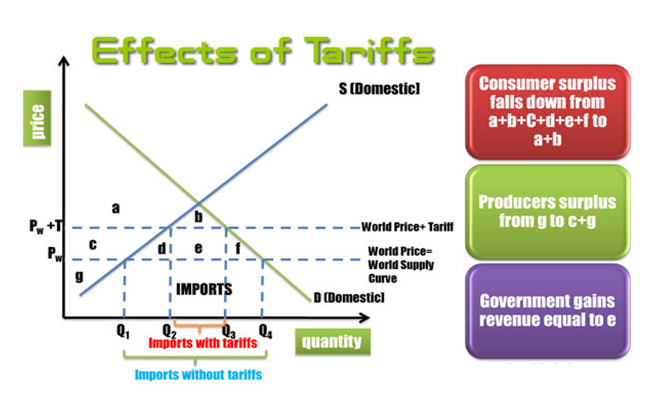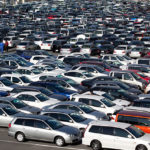
THE ECONOMICS OF IMPORT TARIFF
One of the most important issues in a country’s economy is trading; therefore, tariffs are most often discussed when talking about imported goods. A tariff is simply a tax or duty placed on an imported good by a domestic government. Tariffs are usually levied as a percentage of the declared value of the good, similar to a sales tax. However, unlike a sales tax, tariff rates are often different for every good, and tariffs do not apply to domestically produced goods. The effect of tariff is to significantly raise the domestic price at which the foreign imported product is sold per unit. Therefore, tariffs do affect the economy and also change consumers and producers’ behavior. All over the world, countries trade with one another, depending on how much of the other country’s goods they need and the level of their local production.
Why Import Tariff?
There are three standard situations in which governments impose tariffs.
First is to protect fledgling domestic industries from foreign competition. The original concept behind this is to defend domestic industries from foreign capital that would naturally have comparative or absolute advantages over domestic alternatives. In elementary economics, it is called the Infant Industry Argument. The core of the argument is that nascent industries often do not have the economies of scale that their older competitors from other countries may have, and thus need to be protected until they can attain similar economies of scale.
Secondly, it may be to protect aging and inefficient domestic industries from foreign competition. Many have argued that with the rapid technological advancement and fast-paced industrialization in many developed countries, the ageing and obsolete production processes of most developing countries do not stand a chance in terms of maximization of economies of scale and its cascading impact on cost of productions and the value at which the resultant output can be marketed.
Finally, it may also be to protect domestic producers from dumping by foreign companies or governments. Dumping means selling goods lower than production cost which is much lower than the fair price. It occurs when a foreign company charges a price in the domestic market which is considered “too low”. In most instances “too low” is generally understood to be a price which is lower in a foreign market than the price in the domestic market. It could also mean a price which is below cost, so the producer is losing money probably as a preferred alternative to being saddled with unsold and fast depreciating inventory or as a desperate strategy to forcefully penetrate a market by creating an unfair competition.
By whatever yardstick it is considered, the impact of tariffs on the economy is not trivial. From a global economy perspective, the World Bank estimates that if all barriers to trade such as tariffs were eliminated, the global expansion of world economy by $830Billion is achievable by 2015.
Tariffs impacts upon the economies of both the country imposing and that of the countries from which the products are imported especially when the imposing country occupies a significant position in the demand equation for the affected products. In almost all instances the tariff causes a net loss to the economies of both the country imposing the tariff and the country the tariff is imposed on.
Theoretical Impact of tariff on the domestic economy
Except in all but the rarest of instances, tariffs hurt the country that imposes them, as their costs outweigh their benefits. Tariffs are a boon to domestic producers who now face reduced competition in their home market. The reduced competition causes prices to rise. The sales of domestic producers should also rise, all else being equal (Please NOTE this as we will be coming back to it shortly). The increased production and price causes domestic producers to hire more workers which causes consumer spending to rise. The tariffs also increase government revenues that can be used to the benefit of the economy.
There are costs to tariffs, however. Now the price of the good with the tariff has increased, the consumer is forced to either buy less of this good or less of some other good. The price increase can be thought of as a reduction in consumer income. Since consumers are purchasing less, domestic producers in other industries are selling less, causing a decline in the economy.
Several empirical studies have shown that the benefit caused by the increased domestic production in the tariff protected industry plus the increased government revenues does not offset the losses the increased prices cause consumers and the costs of imposing and collecting the tariff. This is excluding the possibility that other countries might put tariffs on our goods in retaliation, which we know could be costly to us (although the collateral effect of this likelihood should be minimal for a country like Nigeria that very much has little in terms of manufactured products that we export to the nations affected by the new tariff regime. Our exports comprises more of commodities or raw materials for which in most cases there are limited windows open for alternative sourcing. Hence we can be tempted to assume that a retaliatory gesture will most likely ricochet against the offended country). Even if they do not, the tariff is still costly to the economy. Adam Smith’s The Wealth of Nations showed how international trade increases the wealth of an economy. Any mechanism designed to slow international trade will have the effect of reducing economic growth. For these reasons economic theory teaches us that tariffs will be harmful to the country imposing them.
Theoretically speaking, the above paints a clear picture of what to expect when tariff is imposed on imports.
……………………..Continued in Part Three.






